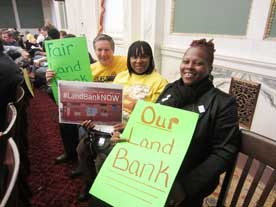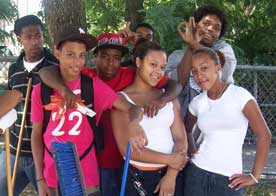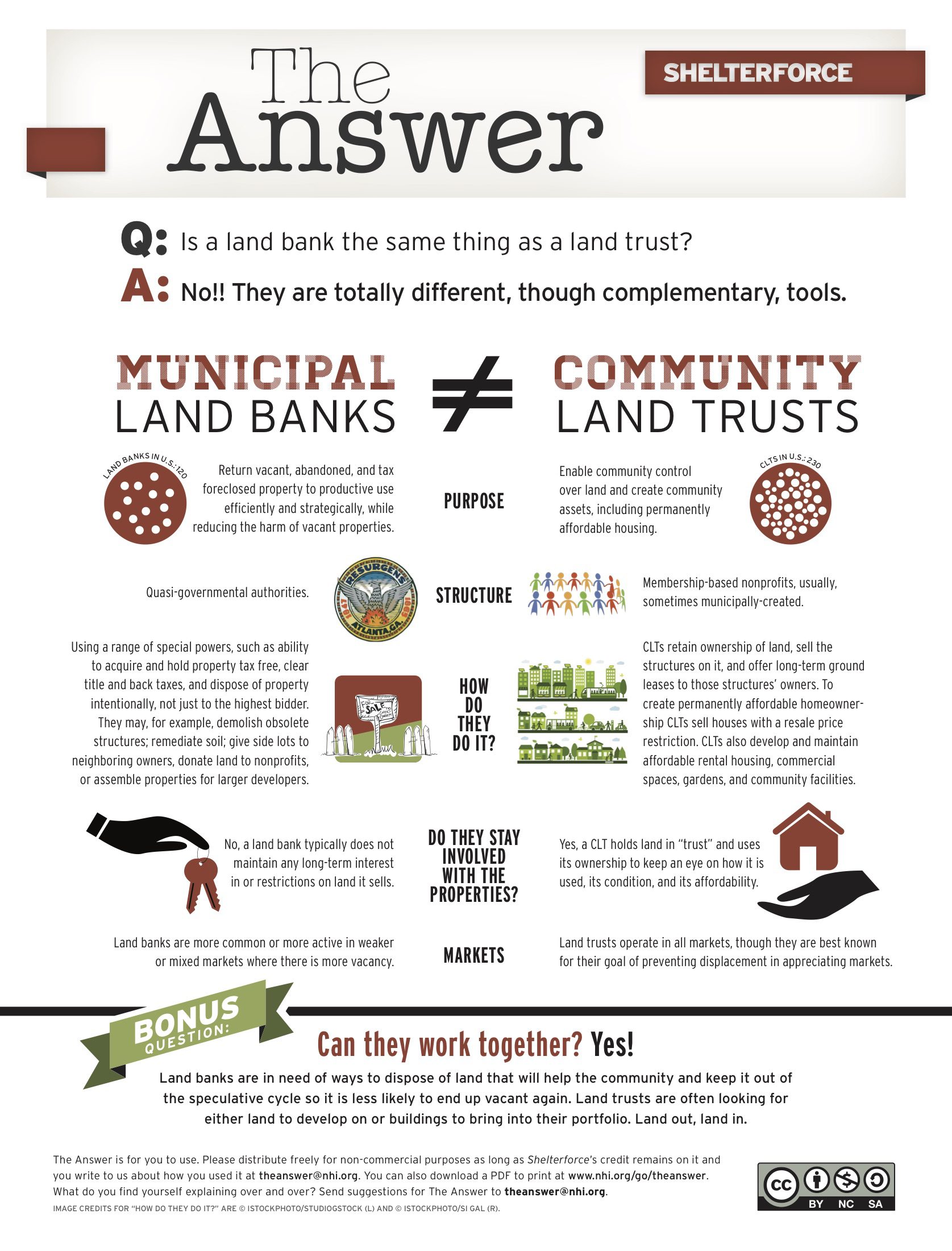I’m standing in one of the most ornate rooms in Philadelphia’s majestic City Hall waiting for the mayor’s arrival. It is Jan. 13, 2014, and the mayor has invited his council colleagues, the press, and the public to watch him sign historic legislation creating a land bank. My mind flashes back to a very different scene, three years before. A small group of affordable housing advocates were evaluating how to work together to prevent displacement from neighborhoods at risk of gentrification. One unusual possibility was a bill pending in the state legislature that would allow Philadelphia to create a land bank to address the problem of blighted property.
We knew that our constituents, who lived predominantly in disinvested neighborhoods, were adversely and disproportionately harmed by the 40,000 vacant lots and abandoned buildings in our city. But while blight was a problem, our folks had bigger a problem: getting squeezed out of neighborhoods with rapidly increasing housing costs. Was there a way to tie these two issues together? The bill circulating in the capitol allowed for land banks to prioritize certain re-uses for land, such as affordable housing. And it required cities to create land banks through the legislative process, providing an opportunity for public input.
As we walked out of the meeting, one of the attendees said to me, “I think we’re on to something that could be awesome. But I don’t see how we have enough juice to make this happen.”
What a difference three years makes! I watched Mayor Michael Nutter remove a pen from his pocket and, amidst much joviality, sign legislation making Philadelphia the largest city in the country to have a land bank. And while I haven’t done an exhaustive comparison, I’m willing to bet no other land bank bill has been as specific (“prescriptive,” our detractors have said) in setting out both a vision and some requirements for how vacant land should be used to promote development without displacement.
So how did we do it? How did we go from a ragtag bunch of committed organizers, leaders, and activists to the Campaign to Take Back Vacant Land, a united 47-member faith, labor, and community coalition that won what may be the most progressive land banking legislation in the country? While I think there were many factors—including hard work, smart strategy, and some luck—here are seven that stand out to me.
Lesson 1: Start with your values
Early on in the process, we developed five key principles that guided our work:
•Public land should be used to create equitable development.
•Community members should have a role in decision-making.
•A land bank should be accountable to communities.
•Decision-making should be transparent.
•Accessing land should be simple.
For each of our priorities, we worked to translate that value into legislative language that could be included in the bill. We talked with experts in the field, including Frank Alexander and Alan Mallach of the Center for Community Progress. We didn’t agree with everything they said, and they didn’t agree with everything we cared about, but they helped us to write language that codified our values.
Lesson 2: Build a big tent
In the beginning of our campaign, we were explicitly tying the idea of a Philadelphia land bank to the concept of community land trusts, neighborhood organizations that protect the long-term affordability of housing and other uses of land. Many of Take Bank Vacant Land’s initial founders were concerned about gentrification pressures in parts of Philadelphia, and were drawn to land trusts’ capacity to protect long-term affordability. Our first draft of legislation had language requiring land to be given to community land trusts. The problem, we quickly learned, was that community land trusts were, in organizing terms, “cutting the issue too narrowly.” In other words, too few organizations and neighborhoods had community land trusts (or the capacity to create one in a short period of time) and they didn’t see their interests in the picture we were painting.
When we broadened our definition of “good land uses” to include the kinds of things that land trusts do (rather than land trusts themselves) we gained a lot more friends. Our coalition grew to include disability rights advocates, labor union members, community farm enthusiasts, and civic associations. We engaged a woman worried about the dramatic increases in rent on her one-bedroom apartment in a university area; a man in a wheelchair frustrated by the indignity of being able to enter and leave his inaccessible home only when someone was available to help him; and a young person energized by the transformative work he witnessed through the creation of a Peace Park in a disinvested section of the city.
Once Take Back Vacant Land had secured all of our priorities in the pending legislation, a broader set of actors joined forces to pass the Philadelphia land bank bill. This Philly Land Bank Alliance, coordinated by the Philadelphia Association of Community Development Corporations, brought additional relationships, including press contacts, and ensured the land bank bill remained in the spotlight.
Lesson 3: Elections are an opportunity for education, and commitments
We deliberately launched Take Back Vacant Land six months before the 2011 primary election (the most important election in a city with one main political party). Take Back Vacant Land activists in distinctive bright yellow T-shirts asked questions at forums all over town, met with candidates to educate them on our vision for a Philadelphia land bank, and asked them to pledge their support. By the time the 2012 city council was in place, we had five supporters in office and we’d created a real buzz about the problem of vacant lots and abandoned buildings in Philadelphia.
Lesson 4: People don’t get excited about improving processes. They get excited about producing results
I hate to break it to passionate anti-blight advocates (and I would count myself among this group), but land banking is not sexy. There’s far too much talk about “streamlining the process” and “returning properties to productive uses.” These are laudable goals but they don’t connect easily or emotionally to a woman living next to a trash-filled vacant lot or an abandoned house. Talk to her about the power of a land bank to get that property out of the hands of a speculator and into hers for a community garden, and you’re on to something.
Take Back Vacant Land excelled at explaining the possibilities of a land bank in ways that mobilized people from all over the city. The day after the bill hearing, I read the Philadelphia Daily News with pride. “Reporters, who usually have little company at these bureaucratic proceedings,” the columnist wrote, “were almost giddy at the display of civic involvement.”
Lesson 5: Combine strategy and creativity
Two years into the campaign, we were feeling a little discouraged by our progress. We had decent legislation introduced in city council, but it needed to be stronger. And the bill needed to move. In a brainstorming session, a Take Back Vacant Land member had the idea to run a citywide best lot/worst lot contest. Worst Lot entries would galvanize people about the ugliness of blight, while the Best Lot entries would underscore our message of what good can happen in communities when land is controlled by people who live there. We advertised the contest all over the city, reviewed submissions, and selected winners.
One gentleman from North Philadelphia whose granddaughter heard about the contest on television took the bus to our office to hand-deliver an essay about his painstaking work to transform a blighted lot (the result of knocking down an abandoned house) into a beautiful garden next door. He won third place, which tells you something about the quality of the other entries! The campaign itself, and the winners, received print and television coverage, and our message about the land bank’s potential reached a broader audience.
Lesson 6: Choose your battles
The final weeks of the land bank push came down to the role of city council members in making decisions about land in their districts. This was an issue that Take Back Vacant Land debated early on, with some members feeling very strongly that we had to work to limit this power—“They’ll just reward their allies and punish their enemies,” people fretted—while others argued the pragmatic limitations of securing a majority vote in city council on a bill that would limit a councilmember’s power. In the end, we set aside the issue of trying to change the role of district council people in decisions about vacant land, opting instead to fight for two elements of transparency that would shine light on those decisions—a requirement to publish the sale price, buyer, and intended use for all land bank sales and an annual impact statement to track progress on equitable development goals.
Lesson 7: Celebrate, celebrate, celebrate
We had dozens of Take Back Vacant Land members (in our yellow T-shirts) at City Hall when Mayor Nutter signed the bill into law. In follow-up conversations with people, I’ve been repeatedly struck by how moving that moment was to people. “We worked so hard and so long on the land bank. It felt good to watch the mayor sign that darn bill,” one woman told me. I often think, “OK, that’s done, on to the next thing.” But stopping and celebrating what we did—and what we did together—is an important way to energize people for what comes next.
Our work isn’t done. The Philadelphia land bank is in its infancy, and there’s organizing work to make sure it’s implemented in accordance with our vision. But we’re hopeful. And that’s a great place to be.
Jill Feldstein was the organizing director for the Women’s Community Revitalization Project during the land bank campaign, and helped coordinate the Take Back Vacant Land coalition.






Comments